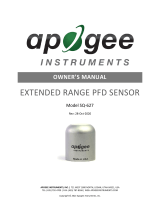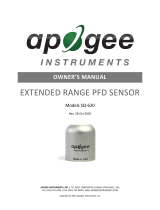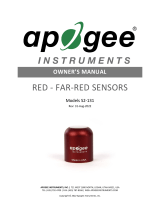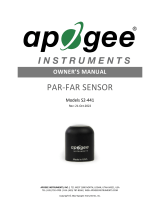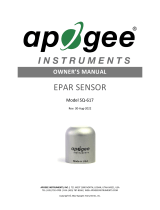
APOGEE INSTRUMENTS, INC. | 721 WEST 1800 NORTH, LOGAN, UTAH 84321, USA
TEL: (435) 792-4700 | FAX: (435) 787-8268 | WEB: APOGEEINSTRUMENTS.COM
Copyright © 2022 Apogee Instruments, Inc.
OWNER’S MANUAL
QUANTUM LIGHT POLLUTION
SENSOR
Model SQ-647
Rev: 30-Aug-2022

TABLE OF CONTENTS
Owner’s Manual ............................................................................................................................................................ 1
Certificates of Compliance ..................................................................................................................................... 3
Introduction ........................................................................................................................................................... 5
Sensor Models ....................................................................................................................................................... 6
Specifications ......................................................................................................................................................... 6
Deployment and Installation ................................................................................................................................. 9
Cable Connectors ................................................................................................................................................... 9
Operation and Measurement .............................................................................................................................. 11
Maintenance and Recalibration .......................................................................................................................... 17
Troubleshooting and Customer Support ............................................................................................................. 18
Return and Warranty Policy ................................................................................................................................ 19

CERTIFICATE OF COMPLIANCE
EU Declaration of Conformity
This declaration of conformity is issued under the sole responsibility of the manufacturer:
Apogee Instruments, Inc.
721 W 1800 N
Logan, Utah 84321
USA
for the following product(s):
Models: SQ-647
Type: Quantum Light Pollution Sensor
The object of the declaration described above is in conformity with the relevant Union harmonization legislation:
2014/30/EU Electromagnetic Compatibility (EMC) Directive
2011/65/EU Restriction of Hazardous Substances (RoHS 2) Directive
2015/863/EU Amending Annex II to Directive 2011/65/EU (RoHS 3)
Standards referenced during compliance assessment:
EN 61326-1:2013 Electrical equipment for measurement, control, and laboratory use – EMC requirements
EN 63000:2018 Technical documentation for the assessment of electrical and electronic products with
respect to the restriction of hazardous substances
Please be advised that based on the information available to us from our raw material suppliers, the products
manufactured by us do not contain, as intentional additives, any of the restricted materials including lead (see
note below), mercury, cadmium, hexavalent chromium, polybrominated biphenyls (PBB), polybrominated
diphenyls (PBDE), bis (2-ethylhexyl) phthalate (DEHP), butyl benzyl phthalate (BBP), dibutyl phthalate (DBP), and
diisobutyl phthalate (DIBP). However, please note that articles containing greater than 0.1 % lead concentration
are RoHS 3 compliant using exemption 6c.
Further note that Apogee Instruments does not specifically run any analysis on our raw materials or end products
for the presence of these substances, but we rely on the information provided to us by our material suppliers.
Signed for and on behalf of:
Apogee Instruments, August 2022
Bruce Bugbee
President
Apogee Instruments, Inc.

CERTIFICATE OF COMPLIANCE
UK Declaration of Conformity
This declaration of conformity is issued under the sole responsibility of the manufacturer:
Apogee Instruments, Inc.
721 W 1800 N
Logan, Utah 84321
USA
for the following product(s):
Models: SQ-647
Type: Quantum Light Pollution Sensor
The object of the declaration described above is in conformity with the relevant UK Statutory Instruments and
their amendments:
2016 No. 1091 The Electromagnetic Compatibility Regulations 2016
2012 No. 3032 The Restriction of the Use of Certain Hazardous Substances in Electrical and Electronic
Equipment Regulations 2012
Standards referenced during compliance assessment:
BS EN 61326-1:2013 Electrical equipment for measurement, control, and laboratory use – EMC requirements
BS EN 63000:2018 Technical documentation for the assessment of electrical and electronic products with
respect to the restriction of hazardous substances
Please be advised that based on the information available to us from our raw material suppliers, the products
manufactured by us do not contain, as intentional additives, any of the restricted materials including lead (see
note below), mercury, cadmium, hexavalent chromium, polybrominated biphenyls (PBB), polybrominated
diphenyls (PBDE), bis (2-ethylhexyl) phthalate (DEHP), butyl benzyl phthalate (BBP), dibutyl phthalate (DBP), and
diisobutyl phthalate (DIBP). However, please note that articles containing greater than 0.1 % lead concentration
are RoHS 3 compliant using exemption 6c.
Further note that Apogee Instruments does not specifically run any analysis on our raw materials or end products
for the presence of these substances, but we rely on the information provided to us by our material suppliers.
Signed for and on behalf of:
Apogee Instruments, August 2022
Bruce Bugbee
President
Apogee Instruments, Inc.

INTRODUCTION
Radiation that drives photosynthesis is called photosynthetically active radiation (PAR) and is typically defined as
total radiation across a range of 400 to 700 nm. PAR is almost universally quantified as photosynthetic photon flux
density (PPFD) in units of micromoles per square meter per second (µmol m-2 s-1, equal to microEinsteins per
square meter per second) summed from 400 to 700 nm (total number of photons from 400 to 700 nm). However,
ultraviolet and far-red photons outside the defined PAR range of 400-700 nm can also contribute to
photosynthesis and influence plant responses (e.g., flowering).
Sensors that measure PPFD are often called quantum sensors due to the quantized nature of radiation. A quantum
refers to the minimum quantity of radiation, one photon, involved in physical interactions (e.g., absorption by
photosynthetic pigments). In other words, one photon is a single quantum of radiation. Sensors that function like
traditional quantum sensors but measure a wider range of wavelengths can be thought of as an ‘extended range’
quantum sensor.
Typical applications of traditional quantum sensors include incoming PPFD measurement over plant canopies in
outdoor environments or in greenhouses and growth chambers and reflected or under-canopy (transmitted) PPFD
measurement in the same environments. The Extended Range PFD Sensor detailed in this manual uses a detector
that is sensitive to radiation up to about 1100 nm, well beyond the range of wavelengths that influence
photosynthesis and plant responses. This means this particular sensor should only be used for photon flux
density measurements under LEDs.
Apogee Instruments SQ-600 series Quantum Light Pollution Sensors consist of a cast acrylic diffuser (filter),
photodiode, and signal processing circuitry mounted in an anodized aluminum housing, and a cable to connect the
sensor to a measurement device. SQ-600 series sensors are designed for continuous photon flux density
measurements in indoor environments under LEDs. The SQ-640 Quantum Light Pollution models output a voltage
that is directly proportional to photon flux density. The SQ-647 sensors output a digital signal using SDI-12
communication protocol.

SENSOR MODELS
This manual covers the digital model SQ-647 SDI-12 Quantum Light Pollution Sensor (in bold below). Additional
models are covered in their respective manuals.
Model
Signal
SQ-640
Self-powered
SQ-642
0-2.5 V
SQ-644
4-20 mA
SQ-645
0-5 V
SQ-646
USB
SQ-647
SDI-12
SQ-648
Modbus
A sensor’s model number and serial number are
located on the bottom of the sensor. If the
manufacturing date of a specific sensor is required,
please contact Apogee Instruments with the serial
number of the sensor.

SPECIFICATIONS
Calibration Traceability
Apogee Instruments SQ-600 series quantum light pollution sensors are calibrated through side-by-side comparison
to the mean of four transfer standard quantum light pollution sensors under a reference lamp. The transfer
standard quantum light pollution sensors are recalibrated with a quartz halogen lamp traceable to the National
Institute of Standards and Technology (NIST).
SQ-647-SS
Input Voltage
5.5 to 24 V DC
Current Draw
1.4 mA (quiescent), 1.8 mA (active)
Calibration Uncertainty
± 5 % (see Calibration Traceability below)
Measurement Range
0 to 200 µmol m-2 s-1
Measurement
Repeatability
Less than 0.5 %
Calibrated Output Range
0 to 200 mV
Long-term Drift
(Non-stability)
Less than 2 % per year
Non-linearity
Less than 1 % (up to 200 µmol m-2 s-1)
Response Time
0.6 s, time for detector signal to reach 95 % following a step change; fastest data transmission
rate for SDI-12 circuitry is 1 s
Field of View
180°
Spectral Range
340 to 1040 nm ± 5 nm (wavelengths where response is greater than 50 %; see Spectral
Response below)
Directional (Cosine)
Response
± 2 % at 45° zenith angle, ± 5 % at 75° zenith angle (see Directional Response below)
Azimuth Error
Less than 0.5 %
Tilt Error
Less than 0.5 %
Temperature Response
-0.11 ± 0.04 % per C
Uncertainty in Daily Total
Less than 5 %
Housing
Anodized aluminum body with acrylic diffuser
IP Rating
IP68
Operating Environment
-40 to 70 C; 0 to 100 % relative humidity; can be submerged in water up to depths of 30 m
Dimensions
30.5 mm diameter, 37 mm height
Mass (with 5 m of cable)
140 g
Cable
5 m of two conductor, shielded, twisted-pair wire; TPR jacket; pigtail lead wires; stainless steel
(316), M8 connector

Spectral Response
Cosine Response
Directional, or cosine, response is defined as the
measurement error at a specific angle of radiation
incidence. Error for Apogee SQ-600 series Quantum
Light Pollution Sensor is approximately ± 2 % and ± 5 %
at solar zenith angles of 45° and 75°, respectively.
Mean spectral response measurements of
six replicate Apogee SQ-600 series
Quantum Light Pollution Sensors. Spectral
response measurements were made at 10
nm increments across a wavelength range
of 300 to 1100 nm in a monochromator
with an attached electric light source.
Measured spectral data from each
quantum light pollution sensor were
normalized by the measured spectral
response of the monochromator/electric
light combination, which was measured
with a spectroradiometer

DEPLOYMENT AND INSTALLATION
Mount the sensor to a solid surface with the nylon mounting screw provided. To accurately measure photon flux
density incident on a horizontal surface, the sensor must be level. An Apogee Instruments model AL-100 leveling
plate is recommended for this purpose. To facilitate mounting on a cross arm, an Apogee Instruments model AL-
120 mounting bracket is recommended.
To minimize azimuth error, the sensor should be mounted with the cable pointing toward true north in the
northern hemisphere or true south in the southern hemisphere. Azimuth error is typically less than 0.5 %, but it is
easy to minimize by proper cable orientation.
In addition to orienting the cable to point toward the nearest pole, the sensor should also be mounted such that
obstructions (e.g., weather station tripod/tower or other instrumentation) do not shade the sensor. Once
mounted, the blue cap should be removed from the sensor. The blue cap can be used as a protective covering for
the sensor when it is not in use.
Nylon Screw: 10-32 x 3/8
Model: AL-100
Model: AL-120
Nylon Screw: 10-32 x 3/8

CABLE CONNECTORS
Apogee started offering cable connectors on some
bare-lead sensors in March 2018 to simplify the
process of removing sensors from weather stations
for calibration (the entire cable does not have to be
removed from the station and shipped with the
sensor).
The ruggedized M8 connectors are rated IP68,
made of corrosion-resistant marine-grade stainless-
steel, and designed for extended use in harsh
environmental conditions.
Cable connectors are attached directly to the head.
Instructions
Pins and Wiring Colors: All Apogee connectors
have six pins, but not all pins are used for every
sensor. There may also be unused wire colors
inside the cable. To simplify datalogger
connection, we remove the unused pigtail lead
colors at the datalogger end of the cable.
If a replacement cable is required, please contact
Apogee directly to ensure ordering the proper
pigtail configuration.
Alignment: When reconnecting a sensor, arrows
on the connector jacket and an aligning notch
ensure proper orientation.
Disconnection for extended periods: When
disconnecting the sensor for an extended period
of time from a station, protect the remaining half
of the connector still on the station from water
and dirt with electrical tape or other method.
A reference notch inside the connector ensures
proper alignment before tightening.
When sending sensors in for calibration, only send the
sensor head.
Tightening: Connectors are designed to be firmly
finger-tightened only. There is an o-ring inside the
connector that can be overly compressed if a
wrench is used. Pay attention to thread alignment
to avoid cross-threading. When fully tightened, 1-2
threads may still be visible.
WARNING: Do not tighten the connector by
twisting the black cable or sensor head, only twist
the metal connector (yellow arrows).
Finger-tighten firmly

OPERATION AND MEASUREMENT
The SQ-647 quantum light pollution sensor has a SDI-12 output, where photosynthetically active radiation is
returned in digital format. Measurement of SQ-647 quantum light pollution sensors requires a measurement
device with SDI-12 functionality that includes the M or C command.
Wiring
Sensor Calibration
All Apogee SDI-12 quantum light pollution sensor models (SQ-600 series) have sensor-specific calibration
coefficients determined during the custom calibration process. Coefficients are programmed into the
microcontrollers at the factory.
SDI-12 Interface
The following is a brief explanation of the serial digital interface SDI-12 protocol instructions used in Apogee SQ-
427 quantum light pollution sensors. For questions on the implementation of this protocol, please refer to the
official version of the SDI-12 protocol: http://www.sdi-12.org/specification.php (version 1.4, August 10, 2016).
Overview
During normal communication, the data recorder sends a packet of data to the sensor that consists of an address
and a command. Then, the sensor sends a response. In the following descriptions, SDI-12 commands and
responses are enclosed in quotes. The SDI-12 address and the command/response terminators are defined as
follows:
Sensors come from the factory with the address of “0” for use in single sensor systems. Addresses “1 to 9” and
“A to Z”, or “a to z”, can be used for additional sensors connected to the same SDI-12 bus.
“!” is the last character of a command instruction. In order to be compliant with SDI-12 protocol, all commands
must be terminated with a “!”. SDI-12 language supports a variety of commands. Supported commands for the
Apogee Instruments SQ-627 Extended Range PFD sensors are listed in the following table (“a” is the sensor
address. The following ASCII Characters are valid addresses: “0-9” or “A-Z”).
White: Positive (signal from sensor)
Red: Input Power
Black: Ground (from sensor signal and output power)
Clear: Shield/Ground

Supported Commands for Apogee Instruments SQ-647 Quantum Light Pollution Sensors
Instruction Name
Instruction Syntax
Description
Acknowledge Active Command
a!
Responds if the sensor with address a is on the line
Send Identification Command
aI!
Responds with sensor information
Measurement Command
aM!
Tells the sensor to take a measurement
Measurement Command w/ Check
Character
aMC!
Tells the sensor to take a measurement and return it with a
check character
Change Address Command
aAb!
Changes the sensor address from a to b
Concurrent Measurement Command
aC!
Used to take a measurement when more than one sensor is
used on the same data line
Concurrent Measurement Command
w/ Check Character
aCC!
Used to take a measurement when more than one sensor is
used on the same data line. Data is returned with a check
character.
Address Query Command
?!
Used when the address is unknown to have the sensor identify
its address, all sensors on data line respond
Get Data Command
aD0!
Retrieves the data from a sensor
Verification Command
aV!
Returns sensor coefficients as multiplier, offset, solar
multiplier, and immersion effect correction factor
Running Average Command
aXAVG!
Returns or sets the running average for sensor measurements.
Make Measurement Command: M!
The make measurement command signals a measurement sequence to be performed. Data values generated in
response to this command are stored in the sensor's buffer for subsequent collection using “D” commands. Data
will be retained in sensor storage until another “M”, “C”, or “V” command is
executed. M commands are shown in the following examples:
Command
Response
Response to 0D0!
aM! or aM0!
a0011<cr><If>
Returns µmol m-2 s-1
aM1!
a0011<cr><If>
Returns millivolt output
aM2!
a0011<cr><If>
Returns µmol m-2 s-1
aM3!
a0011<cr><If>
Returns immersed µmol m-2 s-1 for underwater measurements
aM4!
a0011<cr><If>
Returns angle offset from vertical in degrees. (0 degrees if pointed up, 180 degrees if
pointed down.) Available in sensors with serial number 3033 or greater.
aMC! or aMC0!
a0011<cr><If>
Returns µmol m-2 s-1 w/CRC
aMC1!
a0011<cr><If>
Returns millivolt output w/ CRC
aMC2!
a0011<cr><If>
Returns µmol m-2 s-1 w/ CRC
aMC3!
a0011<cr><If>
Returns immersed µmol m-2 s-1 for underwater measurements w/ CRC
aMC4!
a0011<cr><If>
Returns angle offset from vertical in degrees w/CRC. (0 degrees if pointed up, 180 degrees
if pointed down.) Available in sensors with serial numbers 3033 or greater.
where a is the sensor address (“0-9”, “A-Z”, “a-z”) and M is an upper-case ASCII character.

The data values are separated by the sign “+”, as in the following example (0 is the address):
Command
Sensor Response
Sensor Response when data is ready
0M0!
00011<cr><lf>
0<cr><lf>
0D0!
0+2000.0<cr><lf>
0M1!
00011<cr><lf>
0<cr><lf>
0D0!
0+400.0<cr><lf>
0M2!
00011<cr><If>
0<cr><If>
0D0!
0+2000.0<cr><If>
0M3!
00011<cr><If>
0<cr><If>
0D0!
0+2000.0<cr><If>
0M4!
a0011<cr><If>
0<cr><lf>
0D0!
0+90.2<cr><lf>
where 2000.0 is µmol m-2 s-1.
Concurrent Measurement Command: aC!
A concurrent measurement is one which occurs while other SDI-12 sensors on the bus are also making
measurements. This command is similar to the “aM!” command, however, the nn field has an extra digit and the
sensor does not issue a service request when it has completed the measurement. Communicating with other
sensors will NOT abort a concurrent measurement. Data values generated in response to this command are stored
in the sensor's buffer for subsequent collection using “D” commands. The data will be retained in the sensor until
another “M”, “C”, or “V” command is executed:
Command
Response
Response to 0D0!
aC! or aC0!
a00101<cr><lf>
Returns µmol m-2 s-1
aC1!
a00101<cr><lf>
Returns millivolt output
aC2!
a00101<cr><lf>
Returns µmol m-2 s-1
aC3!
a00101<cr><lf>
Returns immersed µmol m-2 s-1 for underwater measurements
aC4!
a00101<cr><lf>
Returns angle offset from vertical in degrees. (0 degrees if pointed up, 180 degrees if
pointed down.) Available in sensors with serial number 3033 or greater.
aCC! or aCC0!
a00101<cr><lf>
Returns µmol m-2 s-1 w/CRC
aCC1!
a00101<cr><lf>
Returns millivolt output w/ CRC
aCC2!
a00101<cr><lf>
Returns µmol m-2 s-1 w/ CRC
aCC3!
a00101<cr><lf>
Returns immersed µmol m-2 s-1 for underwater measurements w/ CRC
aCC4!
a00101<cr><lf>
Returns angle offset from vertical in degrees w/CRC. (0 degrees if pointed up, 180
degrees if pointed down.) Available in sensors with serial numbers 3033 or greater.
where a is the sensor address (“0-9”, “A-Z”, “a-z”, “*”, “?”) and C is an upper-case ASCII character.

For example (0 is the address):
Command
Sensor Response
0C0!
000101<cr><lf>
0D0!
0+2000.0<cr><lf>
0C1!
000101<cr><If>
0D0!
0+400.0<cr><If>
0C2!
000101<cr><lf>
0D0!
0+2000.0<cr><lf>
0C3!
000101<cr><If>
0D0!
0+2000.0<cr><If>
0C4!
000101<cr><If>
0D0!
0+90.2<cr><lf>
where 2000.0 is µmol m-2 s-1 and 400.0 is mV.
Change Sensor Address: aAb!
The change sensor address command allows the sensor address to be changed. If multiple SDI-12 devices are on
the same bus, each device will require a unique SDI-12 address. For example, two SDI-12 sensors with the factory
address of 0 requires changing the address on one of the sensors to a non-zero value in order for both sensors to
communicate properly on the same channel:
Command
Response
Description
aAb!
b<cr><lf>
Change the address of the sensor
where a is the current (old) sensor address (“0-9”, “A-Z”), A is an upper-case ASCII character denoting the
instruction for changing the address, b is the new sensor address to be programmed (“0-9”, “A-Z”), and ! is the
standard character to execute the command. If the address change is successful, the datalogger will respond with
the new address and a <cr><lf>.
Send Identification Command: aI!
The send identification command responds with sensor vendor, model, and version data. Any measurement data
in the sensor's buffer is not disturbed:
Command
Response
Description
"aI!"
a13Apogee SQ-647vvvxx…xx<cr><lf>
The sensor serial number and other identifying values are
returned
where a is the sensor address (“0-9”, “A-Z”, “a-z”, “*”, “?”), 521 is the sensor model number, vvv is a three-
character field specifying the sensor version number, and xx...xx is serial number.

Running Average Command
The running average command can be used to set or query the number of measurements that are averaged
together before returning a value from a M! or MC! command. For example, if a user sends the command
“0XAVG10!” to sensor with address 0, that sensor will average 10 measurements before sending the averaged
value to the logger. To turn off averaging, the user should send the command “aXAVG1” to the sensor. To query
the sensor to see how many measurements are being averaged, send the command “aXAVG!” and the sensor will
return the number of measurements being averaged (see table below). The default for sensors is to have averaging
turned off.
Command Name
Characters Sent
Response
Description
Query running
Average
aXAVG!
an
a = sensor address, n = number of measurements used in
average calculation. Note: n may be multiple digits.
Set running
Average
aXAVGn!
a
a = sensor address, n = number of measurements to be used in
average calculation. Note: n may be any value from 1 to 100.

Low Light Measurements
Accurate low light measurements are required in flowering and light pollution studies. Research indicates
flowering can be triggered in some plants at photosynthetic and/or far-red photon flux densities less than 0.1 mol
m-2 s-1. The threshold photon flux density at which flowering is triggered is variable among species. Two of the
most light-sensitive species are Poinsettias and Cannabis. For reference, photon flux density of moonlight when
the moon is full and near the minimum zenith angle is 0.005 mol m-2 s-1.
The model SQ-620 Extended Range Quantum Sensor can measure a photon flux density range of 0-4000 mol m-2
s-1. The model SQ-640 Quantum Light Pollution Sensor is designed for low light measurements and can only
measure a photon flux density range of 0-200 mol m-2 s-1 (the sensor will output values beyond, 200 mol m-2 s-1,
but these are beyond the linear range of the sensor) and is referred to as the low light version. The sensitivity of
the SQ-640 is twenty times higher than the sensitivity of the SQ-620 (1 mV per mol m-2 s-1 versus 0.05 mV per
mol m-2 s-1) to provide greater measurement resolution under low light conditions. For example, if the photon
flux density were 0.1 mol m-2 s-1, the SQ-640 would output 0.1 mV, whereas the SQ-620 would output 0.005 mV.

MAINTENANCE AND RECALIBRATION
Blocking of the optical path between the target and detector can cause low readings. Occasionally, accumulated
materials on the diffuser of the upward-looking sensor can block the optical path in three common ways:
1. Moisture or debris on the diffuser.
2. Dust during periods of low rainfall.
3. Salt deposit accumulation from evaporation of sea spray or sprinkler irrigation water.
Apogee Instruments upward-looking sensors have a domed diffuser and housing for improved self-cleaning from
rainfall, but active cleaning may be necessary. Dust or organic deposits are best removed using water, or window
cleaner, and a soft cloth or cotton swab. Salt deposits should be dissolved with vinegar and removed with a cloth
or cotton swab. Salt deposits cannot be removed with solvents such as alcohol or acetone. Use only gentle
pressure when cleaning the diffuser with a cotton swab or soft cloth to avoid scratching the outer surface. The
solvent should be allowed to do the cleaning, not mechanical force. Never use abrasive material or cleaner on the
diffuser.
It is recommended that two-band radiometers be recalibrated every two years. See the Apogee webpage for
details regarding return of sensors for recalibration (http://www.apogeeinstruments.com/tech-support-
recalibration-repairs/).

TROUBLESHOOTING AND CUSTOMER SUPPORT
Independent Verification of Functionality
If the sensor does not communicate with the datalogger, use an ammeter to check the current draw. It should be
near 1.4 mA when the sensor is not communicating and spike to approximately 1.8 mA when the sensor is
communicating. Any current drain greater than approximately 6 mA indicates a problem with power supply to the
sensors, wiring of the sensor, or sensor electronics.
Compatible Measurement Devices (Dataloggers/Controllers/Meters)
Any datalogger or meter with SDI-12 functionality that includes the M or C command.
An example datalogger program for Campbell Scientific dataloggers can be found on the Apogee webpage at
https://www.apogeeinstruments.com/content/Quantum-Digital.CR1.
Modifying Cable Length
SDI-12 protocol limits cable length to 60 meters. For multiple sensors connected to the same data line, the
maximum is 600 meters of total cable (e.g., ten sensors with 60 meters of cable per sensor). See Apogee webpage
for details on how to extend sensor cable length (http://www.apogeeinstruments.com/how-to-make-a-
weatherproof-cable-splice/).

RETURN AND WARRANTY POLICY
RETURN POLICY
Apogee Instruments will accept returns within 30 days of purchase as long as the product is in new condition (to be
determined by Apogee). Returns are subject to a 10 % restocking fee.
WARRANTY POLICY
What is Covered
All products manufactured by Apogee Instruments are warranted to be free from defects in materials and craftsmanship
for a period of four (4) years from the date of shipment from our factory. To be considered for warranty coverage an
item must be evaluated by Apogee.
Products not manufactured by Apogee (spectroradiometers, chlorophyll content meters, EE08-SS probes) are covered
for a period of one (1) year.
What is Not Covered
The customer is responsible for all costs associated with the removal, reinstallation, and shipping of suspected warranty
items to our factory.
The warranty does not cover equipment that has been damaged due to the following conditions:
1. Improper installation, use, or abuse.
2. Operation of the instrument outside of its specified operating range.
3. Natural occurrences such as lightning, fire, etc.
4. Unauthorized modification.
5. Improper or unauthorized repair.
Please note that nominal accuracy drift is normal over time. Routine recalibration of sensors/meters is considered part of
proper maintenance and is not covered under warranty.
Who is Covered
This warranty covers the original purchaser of the product or other party who may own it during the warranty period.
What Apogee Will Do
At no charge Apogee will:
1. Either repair or replace (at our discretion) the item under warranty.
2. Ship the item back to the customer by the carrier of our choice.
Different or expedited shipping methods will be at the customer’s expense.

APOGEE INSTRUMENTS, INC. | 721 WEST 1800 NORTH, LOGAN, UTAH 84321, USA
TEL: (435) 792-4700 | FAX: (435) 787-8268 | WEB: APOGEEINSTRUMENTS.COM
Copyright © 2022 Apogee Instruments, Inc.
How To Return An Item
1. Please do not send any products back to Apogee Instruments until you have received a Return Merchandise
Authorization (RMA) number from our technical support department by submitting an online RMA form at
www.apogeeinstruments.com/tech-support-recalibration-repairs/. We will use your RMA number for tracking of the
service item. Call (435) 245-8012 or email techsupport@apogeeinstruments.com with questions.
2. For warranty evaluations, send all RMA sensors and meters back in the following condition: Clean the sensor’s exterior
and cord. Do not modify the sensors or wires, including splicing, cutting wire leads, etc. If a connector has been attached
to the cable end, please include the mating connector – otherwise the sensor connector will be removed in order to
complete the repair/recalibration. Note: When sending back sensors for routine calibration that have Apogee’s standard
stainless-steel connectors, you only need to send the sensor with the 30 cm section of cable and one-half of the
connector. We have mating connectors at our factory that can be used for calibrating the sensor.
3. Please write the RMA number on the outside of the shipping container.
4. Return the item with freight pre-paid and fully insured to our factory address shown below. We are not responsible for
any costs associated with the transportation of products across international borders.
Apogee Instruments, Inc.
721 West 1800 North Logan, UT
84321, USA
5. Upon receipt, Apogee Instruments will determine the cause of failure. If the product is found to be defective in terms
of operation to the published specifications due to a failure of product materials or craftsmanship, Apogee Instruments
will repair or replace the items free of charge. If it is determined that your product is not covered under warranty, you
will be informed and given an estimated repair/replacement cost.
PRODUCTS BEYOND THE WARRANTY PERIOD
For issues with sensors beyond the warranty period, please contact Apogee at techsupport@apogeeinstruments.com to
discuss repair or replacement options.
OTHER TERMS
The available remedy of defects under this warranty is for the repair or replacement of the original product, and Apogee
Instruments is not responsible for any direct, indirect, incidental, or consequential damages, including but not limited to
loss of income, loss of revenue, loss of profit, loss of data, loss of wages, loss of time, loss of sales, accruement of debts
or expenses, injury to personal property, or injury to any person or any other type of damage or loss.
This limited warranty and any disputes arising out of or in connection with this limited warranty ("Disputes") shall be
governed by the laws of the State of Utah, USA, excluding conflicts of law principles and excluding the Convention for the
International Sale of Goods. The courts located in the State of Utah, USA, shall have exclusive jurisdiction over any
Disputes.
This limited warranty gives you specific legal rights, and you may also have other rights, which vary from state to state
and jurisdiction to jurisdiction, and which shall not be affected by this limited warranty. This warranty extends only to
you and cannot by transferred or assigned. If any provision of this limited warranty is unlawful, void, or unenforceable,
that provision shall be deemed severable and shall not affect any remaining provisions. In case of any inconsistency
between the English and other versions of this limited warranty, the English version shall prevail.
This warranty cannot be changed, assumed, or amended by any other person or agreement
/
